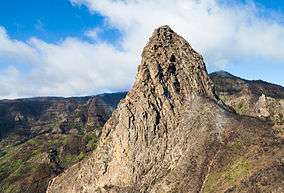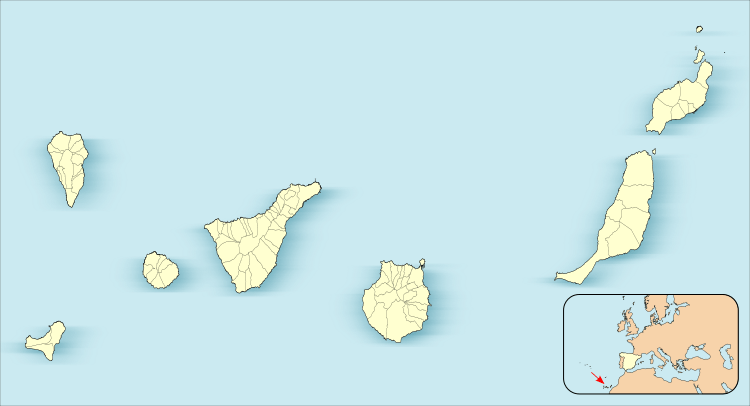Garajonay National Park
Garajonay National Park (Spanish: Parque nacional de Garajonay, pronounced [ˈpaɾke naθjoˈnal de ɣaɾaxoˈnaj]) is located in the center and north of the island of La Gomera, one of the Canary Islands (Spain). It was declared a national park in 1981 and a World Heritage Site by UNESCO in 1986. It occupies 40 km2 (15 sq mi) and it extends into each of the six municipalities on the island.
| Garajonay National Park | |
|---|---|
IUCN category II (national park) | |
 | |
 | |
| Location | La Gomera, Canary Islands, Spain |
| Coordinates | 28°07′34″N 17°14′14″W |
| Area | 40 km2 (15 sq mi) |
| Established | 1981 |
| Type | Natural |
| Criteria | vii, ix |
| Designated | 1986 (10th session) |
| Reference no. | 380 |
| State Party | |
| Region | Europe and North America |
Nearly 450,000 tourists visit the park every year. There is accommodation for tourists just outside the park's boundary.[1]
The park is named after the rock formation of Garajonay, the highest point on the island at 1,487 metres (4,879 ft). It also includes a small plateau whose altitude is 790–1,400 m above sea level.
Attractions
The park provides the best example of Canarian laurisilva, a humid subtropical forest that in the Tertiary covered almost all of Southern Europe. It is also found on the Azores and the Madeira Islands. Laurus azorica, known as Azores laurel, or by the Portuguese names louro, loureiro, louro-da-terra, and louro-de-cheiro, can be found in the park, as well as Laurus novocanariensis, known as Canary laurel. Although named as a single type of forest, the national park englobes several varieties of forests. Most humid and protected valleys oriented to the North have the richest and most complex forests. It is known as valley laurisilva, a true subtropical rainforest where the largest laurel trees can be found. At higher altitudes, with less protection from wind and sun, the forest loses some of its more delicate species. Here it is called slope laurisilva (laurisilva de ladera). At the south the forest is mainly a mix of beech and heather, species adapted to the less humid atmosphere.
Other attractions of the national park are the massive rocks that are found along the island. These are former volcanoes whose shapes have been carved by erosion. Some, like the "Fortaleza" (fortress in Spanish) were considered sacred by the native islanders, as well as ideal refuges when attacked. The park is crossed by a large network of 18 footpaths, trekking being one of the main tourist activities in the island.
Many of the species of flora and fauna are endemic to the Macaronesian islands, the Canary Islands or La Gomera, and the Garajonay forest harbors a rich biota of understory plants, invertebrates, and birds and bats, including a large number of endemic species.
Two species of reptile, Gallotia gomerana (Gomeran lizard) and Chalcides viridanus (Gomeran skink), can be found. Amphibians include the stripeless tree frog, Hyla meridionalis.
The park is renowned as one of the best places to observe the two Canarian endemic pigeons, laurel pigeon (Columba junoniae) and Bolle's pigeon (Columba bollii).
In August 2012, a forest fire burned 747 hectareas (18%) of this national park.[2]
Gara and Jonay
 «Roque Ojila»
«Roque Ojila» «Roque de La Zarcita»
«Roque de La Zarcita»
The peak and park are named after Guanche lore, the hapless lovers Gara and Jonay. Their romance evokes those of Romeo and Juliet and Hero and Leander. Gara was a princess of Agulo on La Gomera. During the festival of Beñesmén, it was customary for unmarried girls of Agulo to gaze at their reflections in the waters of Chorros del Epina. If the water was clear, they would find a husband; if it was cloudy, some misfortune would befall them. When Gara looked at the water, she saw her reflection clearly. However, she gazed too long and the sun's reflection blinded her temporarily. A wise man named Gerián told her that this meant that she needed to avoid all fire or else it would consume her.
Jonay was the son of the Guanche mencey or king of Adeje on Tenerife, who arrived on the island to celebrate these ceremonies. Jonay's participation in the ensuing games attracted the attention of Gara, and the two fell in love. Unfortunately, when the engagement was announced, the volcano Teide, visible from La Gomera, began to erupt as if in disapproval. This was interpreted as a bad omen and the couple’s respective parents broke the engagement. Jonay was made to return to Tenerife, but one night, he swam across the channel that separated the two islands and rejoined his beloved. Their respective fathers ordered that the two be found. The lovers were soon trapped on a mountain, where they decided to take their own lives.
 The park's wooden statues of Gara and Jonay
The park's wooden statues of Gara and Jonay Garajonay National Park seen by Spot Satellite
Garajonay National Park seen by Spot Satellite Enchanted Forest, Garajonay National Park, La Gomera, Spain.
Enchanted Forest, Garajonay National Park, La Gomera, Spain.- Guanche Sanctuary in the summit of Garajonay mountain.
 Laurisilva in the Garajonay National Park.
Laurisilva in the Garajonay National Park.
References
- 갈라호네이국립공원. www.doopedia.co.kr (in Korean). Retrieved 2018-04-16.
- El Cabildo de La Gomera ve una 'planificación malévola' tras el incendio
External links
| Wikimedia Commons has media related to Parque nacional de Garajonay. |
- Garajonay National Park
- Legend of Gara and Jonay (in Spanish)